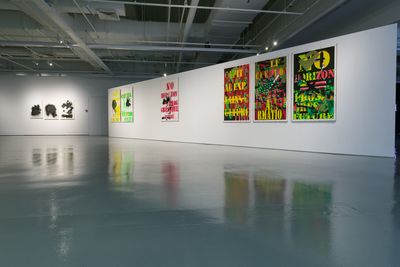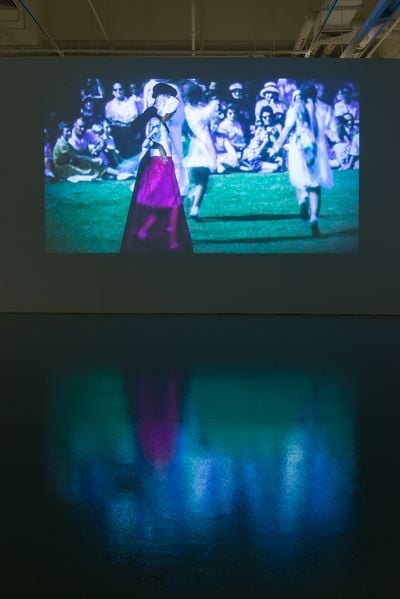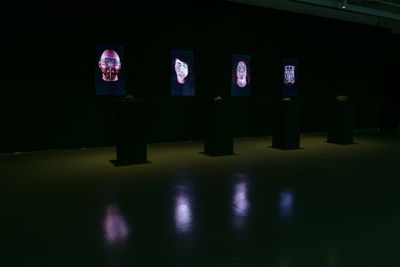City Insight: Propositions for a stage at ICA Singapore
In Propositions for a stage: 24 frames of a beautiful heaven (29 July–22 October 2017), a group show curated by Bridget Crone at the Institute of Contemporary Arts Singapore (ICA Singapore), LASALLE College of the Arts, the curator evokes a range of ideas and references with the exhibition's title. First, the philosopher David Lewis' notion that time travel is possible and allows, mysteriously, for closed causal loops, similar to the sort of closed bubbles of space and time that theatre and the stage exert. The curator goes on to liken these to the still frames of film that nonetheless move when observed 24 times a second, and asserts that the gallery has been transformed into such a 'constellation of micro-theatres.'

Uriel Orlow, The Reconnaissance (with Paused Prospect and Paused Retrospect), from the project Unmade Film (2012–13). Installation view: Propositions for a stage: 24 frames of a beautiful heaven, Institute of Contemporary Arts Singapore, LASALLE College of the Arts (29 July–22 October 2017). © Courtesy the artist. Photo: Weizhong Deng.
This description rings true upon entering the gallery, with most of the artworks being somewhat shielded from view, each partially sectioned-off, offering sidelong glimpses, or hinting at their presence as multiple audio components blend into a low susurrus.
Amanda Beech's Cause and Effect series (2016) is the most visible work upon entry, with most of the series hung on a long, free-standing partition which dissects the gallery in two. Beech's nine large works on paper evince a sense of progression, with the nearest, rightmost image being a dense, lurid mass of partially effaced text (such as 'CAPITAL DOES NOT EXPLAIN CULTURE') and geometric patterns, with a gradual loss of visual density—the leftmost image is but a jagged black blob on white.
Even the text undergoes degradation, with the aforementioned slogan seemingly re-appearing as 'CAPITAL CULTURE CULTUR' [sic]. Paired with the visual stridency of Cause and Effect, the overall impression is of a badly degraded announcement repeated on some abandoned public address system. Speculating on the rules governing this progression of images, however, may result in frustration or outright apophenic delusion, with the artist's statement describing the relationships within the series as 'a game system of faking cause'. In other words, there is no logic to the progression of Beech's imagery, only the deceptive appearance of one—though presumably she refers to a set of rules more specific than 'at irregular intervals, from right to left, a reduction of visual information.'
To the left side of Beech's work are Uriel Orlow's The Reconnaissance (with Paused Prospect and Paused Retrospect) (2012–13) and The Fairest Heritage (2016–17). The most magnetic feature of The Reconnaissance is a wall-to-wall print of a hilly, picturesque vista—large enough to feel like one is encountering a portal to the place depicted—along with a number of photographs leaning on each other at the foot of a wall, and a slide projector which presents further images of the landscape. The experience of absorbing this terrain while untangling what Orlow thought significant about it is somewhat didactically prompted by an audio recording of a three-way conversation musing on the horrors of the site's past, and the blandly temperate visage it presents, like a macabre version of Paris Syndrome, or some mutation of the banality of evil. The vistas in question actually consist of two Palestinian locations: Lifta, the only remaining ruin of the 400 villages that were depopulated in 1948, and a new, unfinished construction near Ramallah.
Another set of visuals paired with ruminative speech is Rabih Mroué's Duo for two missing persons (2013), with one key difference being that Mroué's video-accompanied musings are more speculative in nature. Located on the other side of Amanda Beech's Cause and Effect series, Mroué traces a wandering path from the logistical difficulties of reassembling the dead found in mass graves—complete with a discussion of a graph of possible combinations of body parts—and his attempt to have said graph interpreted by a choreographer as a dance. Appropriately, given the exhibition's title, the choreographer's response prompts thoughts on Zeno's Arrow Paradox, and a further comparison—closing the loop—of Baroque dance diagrams to the dead.
Perhaps the most visually arresting series of the exhibition is Zach Blas' Face Cages (2013–16), which are exactly as their title suggests three-dimensional printed steel structures presented on plinths and worn by performers in videos. There is a chilly savagery to their polygonal forms, purportedly derived from facial recognition software's measurements of each wearer's face—although Blas' own cage doesn't seem to fit the bill. With these simple images, Blas evokes the spectre of tyranny through biometry, as aided by ubiquitous surveillance and machine learning; one might imagine characters in a William Gibson novel wearing these as defiant adornments. The 'endurance performances' underlying the videos, however, are simultaneously undermining themselves while also doing the opposite—their durations of 10 to 12 minutes slickly smeared into a barely registered eternity.
Rounding out the exhibition is Ming Wong's multifaceted The bamboo spaceship (2017), in which multiple elements within his 'micro-stage' compete for attention in an oddly complementary, cohesive fashion. Central to the installation is the strange collision between traditional Cantonese opera and Soviet-era science fiction—most notably, Andrei Tarkovsky's Solaris (1972), footage of which is interweaved with its reinterpretation in a stage production of Cantonese opera.
This bizarre, anachronistic vision of futurity is doubly resonant with part of the exhibition's title being adapted from Pan Haitian's speculative fiction novel 24 Second Paradise (2009–10), which evokes both time travel and the 24 frame-per-second standard of film. For all the title's potential of transcendent beauty, the looped time which exists in the show also has qualities of a nightmare, of nested dreams of an uncertain depth, and of running in the dark to the sound of a Shepard-Risset glissando, certain that there's something right behind you. —[O]








































































































































































